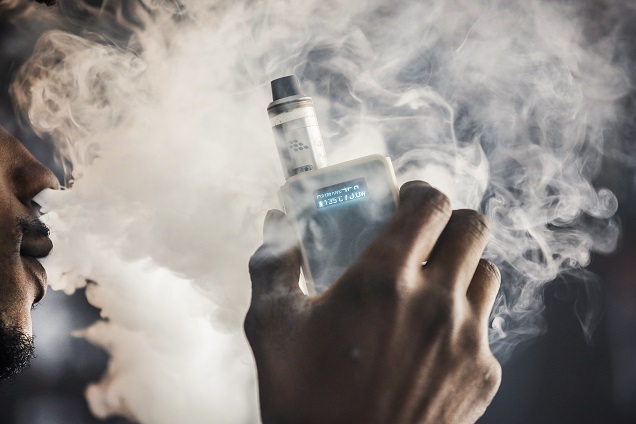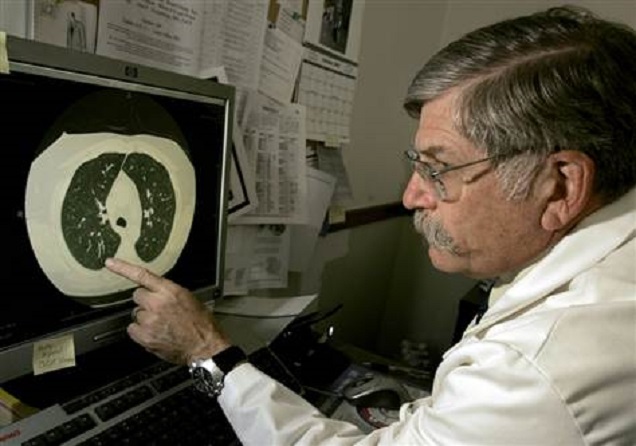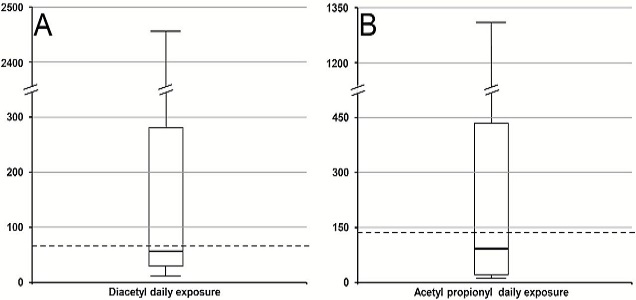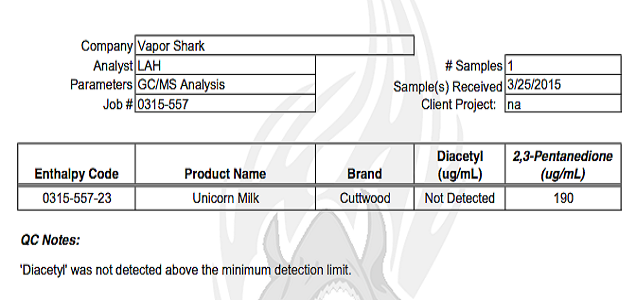
Will vaping give you popcorn lung? Should you be worried about diacetyl? Does your favorite e-juice contain diacetyl? Is acetyl propionyl any better?
The concern about diacetyl has now hit the mainstream. This is due to the release of the recent Harvard study looking at diacetyl in e-cigarettes, and attracting a lot of headline in the process. For vapers, the study may re-ignite fears about the presence of diacetyl in e-juice. For smokers, it could even put them off making the switch to vaping altogether.
But the issue isn't as clear-cut as it might seem. The new study presents a skewed picture of the potential dangers of diacetyl in e-cigarettes, especially the news reporting of it. On the other side, many vaping sites have a tendency to play down the potential risks of diacetyl.
So here’s a straightforward, objective guide to the issue of diacetyl in e-cigarettes. The aim is simple: to give you all the information you need to make an informed decision about what you vape.
Summary / TL;DR
- Diacetyl is a key component of a buttery flavor, and is used in e-liquids to produce that taste. It’s delicious.
- Reports from popcorn factories show that workers exposed to the most diacetyl (and other chemicals) can get a condition called bronchiolitis obliterans (“popcorn lung”).
- Tests in animals show that inhaling large amounts of diacetyl can lead to lung damage. However, the effect is smaller at doses more like those vapers are exposed to.
- According to NIOSH limits, about 65 μg of diacetyl per day is associated with a risk of 1/1000 for reduced lung function. However, this probably isn’t perfectly applicable to vaping.
- Based on two studies of diacetyl in e-juice, a vaper consuming 3 – 5 ml of diacetyl-containing e-liquid per day will usually be below the recommended exposure limit. In many cases, though, they will exceed it.
- A pack-a-day smoker will inhale anything from 60 to 240 times more diacetyl than a vaper.
- Despite claims to the contrary, smokers probably do get popcorn lung, or lung damage due to diacetyl.
- Acetyl propionyl is often used instead of diacetyl, but the risks are probably similar.
- To avoid diacetyl, only buy juices or flavorings from companies that provide a lab test. An assurance of “no diacetyl” isn’t good enough.
- Overall, the risk of diacetyl from vaping is almost certainly much lower than from smoking, but there is still a risk. It might not be a big risk, but it’s almost certainly present.
What is Diacetyl?
Diacetyl is a chemical commonly associated with microwave popcorn and (more specifically) butter. It's also often found in beer and wine (as a result of the fermentation process), and occurs naturally in some fruits. The FDA classes diacetyl as “generally recognized as safe.”

Chemically, it’s classed as a diketone, which means it contains two double-bonds of carbon and oxygen (called “carbonyl” groups), each linked to two carbon atoms. Diacetyl is the simplest diketone, but other chemicals – such as acetyl propionyl – also fall into this class.
Why is Diacetyl Used in E-Juice?
The reason diacetyl is often found in e-juice is very simple: it tastes really nice. There is more to it than this, but there’s no getting away from this core point.
Really, though, the use of diacetyl comes down to flavor chemistry. The main components of a buttery flavor are diacetyl and acetoin, and if you want something to have a buttery taste, there are only so many ways you can accomplish it.
The Perfumer’s Apprentice (an e-juice flavoring supplier) explains the general issue. They don’t use diacetyl, so they use the similar chemicals acetyl propionyl and acetoin to illustrate the point:
Just like it would be hard to bake a cinnamon cookie with no cinnamon, it would be really hard (pretty much impossible) to create a vanilla custard flavor with no acetoin or acetyl propionyl (or diacetyl).
In short: there are some flavors that would be very difficult to create without diacetyl.
Are There Risks to Inhaling Diacetyl?
The FDA says diacetyl is generally recognized as safe. However, this classification does not apply to inhalation, only ingestion. For the inhalation of diacetyl, the evidence of risk is pretty solid.
The first sign of problems from diacetyl exposure began to surface in the 1980s. Two young, non-smoking workers at a bakery flavor manufacturing plant developed an obstructive lung disease. The plant in question regularly used diacetyl.
In the early 2000s, there was a spate of similar case reports. Workers in popcorn plants were developing a condition called bronchiolitis obliterans. The press dubbed this condition “popcorn lung” because of this association.

The report which drew attention to this issue came from a Missouri popcorn factory. There, eight cases of the condition in former workers were reported in 2000. A New England Journal of Medicine studyreported on these cases, and other studies also looked at these and other cases. The National Institute for Occupational Safety and Health (NIOSH) investigated six microwave popcorn plants in total, and several consistent findings emerged.
- Exposure to diacetyl led to declines in the amount of air workers could exhale in one second. This is an important measure of lung function. More exposure led to bigger declines in lung function.
- The people who got the condition weren’t spread evenly through the plant. They all worked in the mixing room (where the flavorings are mixed with salt and oil) and the packaging room (where flavoring mixtures are bagged up with the corn), with no cases in the other areas. These areas had the highest diacetyl levels in the air.
- Mixers had more chest symptoms and worse lung function than people who’d never worked as mixers. These were exposed to the most diacetyl.
- Those who’d worked as mixers for longer had worse lung function and more shortness of breath.
- Some of the workers smoked, but this didn’t appear to be a causal factor in the cases. Only one of the six smokers was in the age-range where smoking-related breathing problems would be expected. Additionally, the heaviest smoker actually had the least lung function impairment.
However, there is a potential problem with these findings: there were many potentially harmful chemicals in the air. For example, the mixing room contained over 100 volatile organic compounds. How do they know it’s diacetyl to blame, rather than some other chemical? Diacetyl was the dominant component in the air, but it could be that diacetyl just happened to co-occur with the true cause of the problems.
But it probably was the diacetyl. Studies of mice and rats confirmed that diacetyl – albeit at high concentrations – damages the airways, both alone and in a mixture from heated butter flavoring, and that the diacetyl causes damage similar to that seen from popcorn lung. These studies establish a direct, causal link between diacetyl in particular and lung damage. However, at lower doses (more like those vapers are exposed to), it’s important to note that the effects were much smaller.
Two studies from diacetyl manufacturing plants show that diacetyl exposure leads to respiratory symptoms. The workers in these studies were exposed to much fewer different chemicals, so diacetyl is more clearly implicated. Also, some of the workers who were exposed the most developed popcorn lung.
Finally, one long-term consumer of microwave popcorn developed popcorn lung. This was after eating two bags a day for ten years, and inhaling the fumes as he opened the bag.
All of this evidence points to one conclusion: inhaling diacetyl can and does cause lung problems.
Bronchiolitis Obliterans: “Popcorn Lung” Disease

Bronchiolitis obliterans is a rare but serious condition. The bronchioles (the smallest airways in the lungs) become inflamed and damaged, and the resulting scarring blocks off the airways.
The main symptoms this causes are a dry cough, shortness of breath and wheezing. These generally come on gradually and get progressively worse.
The condition doesn’t respond well to treatment, either, and severe cases may need a lung transplant. After some time unexposed, the coughing settles down. However, the reduced lung functioning and shortness of breath during physical activity continue.
How Much Diacetyl is Dangerous?
In the studies of the popcorn workers, the level of diacetyl in the mixing room (where workers experienced the worst symptoms) was just over 32 parts per million (ppm), and in the packaging room it was just under 2 ppm. In the studies in diacetyl manufacturing plants, levels ranged from about 1 ppm to just over 110 ppm. In the animal studies, concentrations of 200 to 400 ppm were most widely used.
The research led NIOSH to establish a maximum workplace diacetyl level of 5 ppb (as an 8-hour average). This exposure level would lead to a 1 in 1000 chance of suffering reduced lung function as a result of diacetyl exposure. This is considered to be a pretty strict limit.
In his study of diacetyl (and acetyl propionyl) in e-juice, Dr. Farsalinos calculated the maximum daily intake implied by this limit as 65 μg (micrograms) for diacetyl (and 137 μg for acetyl propionyl).
How Much Diacetyl is in E-Juice?
Two studies have looked at diacetyl levels in e-juice, Dr. Farsalinos’ study and the recent study from Harvard researchers.
Both of these studies focused on sweet-flavored e-liquids, which are more likely to contain diacetyl. As a result, both studies found that around three-quarters of juices have diacetyl. The median level in Dr. Farsalinos’ study was 20 μg/ml, and in the Harvard study, the average was around 9.2 μg per e-cigarette. (Per e-cigarette can be roughly estimated as per ml, since these were cigalike cartridges.)
The latter calculation is slightly simplified. Samples with no detectable diacetyl were counted as containing none at all (even though they may have had some), and ones below the limit of quantification were classed as containing 2.3 μg (although they’d all contain less than this). Dr. Michael Siegel calculated the average as 9.0 μg, so it’s probably reasonably accurate.

Based on an estimated liquid usage of 3 ml per day, Dr. Farsalinos’ study puts the median exposure at just under the NIOSH limit. With the same assumption, the new study would lead to vapers consuming less than half than the daily recommended exposure limit. At 5 ml per day consumption, Dr. Farsalinos’ study would put vapers over the recommended limit, but the new study still wouldn’t.
The limit is based on exposure during working hours alone. This means it assumes a break in the evening and the weekend off, but also that it's inhaled with every breath. It may not be completely appropriate (there’s some debate about this), but it gives a ball-park figure.
How Much Diacetyl is in Cigarette Smoke?
The biggest criticism of the latest study is that the authors completely ignore the fact that diacetyl is present in cigarette smoke. So for a smoker switching to vaping, the most crucial comparison is between cigarette smoke and e-cig vapor.

The amount of diacetyl in cigarette smoke has been measured by at least two studies. One put the average diacetyl content of a single cigarette at 335.9 μg, and the other at 285 μg. This means, for a pack-a-day smoker, the average diacetyl intake would be between 5,700 and 6,718 μg.
This is anything from 60 to over 240 times more than the intake from vaping. This just depends on which diacetyl figure you use and whether 3 or 5 ml of e-liquid is consumed per day. In terms of diacetyl exposure, cigarettes are undoubtedly a much bigger risk than e-cigarettes.
MYTH: “But Smokers Don’t Even Get Popcorn Lung”
If you’ve read anything about this study from many supporters of vaping, even Michael Siegel, these comparisons are often followed up with what seems like a killer blow to the whole hypothesis: you hardly associate smoking with popcorn lung. It’s simply not on the large list of conditions that smoking is known to cause. Dr. Siegel points to a study making this assertion and questioning the link between diacetyl and popcorn lung as a result.
However, this was addressed by Dr. Farsalinos in his study. He points out that smoke contains many chemicals that irritate the airways, and these may work alongside diacetyl and produce a different effect to diacetyl alone. The problem is compounded by the fact that lung problems in smokers are much more common than popcorn lung in people exposed to diacetyl.
Additionally, popcorn lung is often misdiagnosed. This was reported in the original New England Journal of Medicine study about diacetyl exposure in the popcorn workers. They were often diagnosed with asthma or chronic bronchitis, not popcorn lung.
Finally, examinations of young smokers’ lungs (after death) have revealed tissue damage much like that seen in popcorn lung.
In other words: smokers probably do get popcorn lung. At very least, the diacetyl in cigarette smoke contributes to the multitude of lung problems they do get. The argument that “smokers don’t get popcorn lung so vapers won’t either” is basically invalid.
Is the Evidence From Factories Relevant to Vaping?
The other commonly-raised point about diacetyl in e-cigarettes is that the evidence comes from factory workers, who are obviously exposed in a different way to vapers. However, brushing the risks of diacetyl aside on this basis is a little too lax. In the mixing room of the factories, diacetyl levels were 32 ppm. In the median e-liquid in Dr. Farsalinos’ study, the levels in e-liquid were 20 ppm.
Yes, factory-workers are exposed with every breath. And yes, the levels in the air in the main room of concern where higher than in most e-liquids. But the risk can’t be discounted quite so easily. As mentioned earlier, the occupational limits assume 16 hours a day unexposed, and two full unexposed days at the weekend. Vapers don’t have continuous exposure like factory workers, but many will also be exposed through the day, and all will be exposed at the weekend too.
The other variable is the amount of diacetyl in the juice. This can vary both ways: you can get completely diacetyl-free juice, but many of the juices in both studies contained much higher levels than the average. If you vape a variety of sweet flavors – like most vapers – you’ll probably be exposed to varying levels with each flavor. Some will be diacetyl-free, some will have average levels, and some will be a lot higher than average.
The question of whether the level of exposure for a vaper is anything to worry about isn’t easy to answer. The rarity of popcorn lung and the fact that most juices only have low levels suggests that it probably won’t be too common. However, many juices are above recommended limits, and levels are often comparable with those in the air of the mixing room in the popcorn factory (or higher). It may be small, but the risk definitely exists.
The key point is that you are clearly reducing your risk of diacetyl-related problems by switching to vaping. That much is undeniable, and should have been stressed a lot more in the recent study and the reporting of its findings. But this doesn’t mean that the risk is non-existent.
Acetyl Propionyl: Different Chemical, Same Problems
The problems with diacetyl led to widespread switching to acetyl propionyl (or 2,3-pentanedione). This was also found in e-juices in both studies. It’s similarity to diacetyl means that it can fill the same role pretty nicely when it comes to flavor.
However, it’s similarity to diacetyl also means it probably has the same effects on the lungs, too. Experiments in rats and others in mice have suggested that this is probably the case. NIOSH suggests that the risks of diacetyl are likely shared by most other similar chemicals.
There may not be any evidence of related lung disease in humans yet, but every indication is that it will probably cause the same problems.
How Can Vapers Avoid Diacetyl and Acetyl Propionyl?
So while vaping diacetyl-containing juices probably isn’t going to pose a huge risk, it's still one that some may prefer to avoid. Or, at very least, would prefer to be aware of.
Sadly, the studies conducted have shown that a mixer saying their juices are diacetyl free isn’t really reliable. They may well contain diacetyl anyway. It isn’t necessarily lying – some flavoring sellers don’t make it clear whether the concentrates contain diacetyl – but it’s definitely a lax attitude to what they’re putting in your juice.
The upshot is that there are only two ways to ensure your juice is diacetyl free: only buy from companies that offer test results or mix juice yourself.
The problem with looking for test results is that a lot of companies don’t provide them. There are many exceptions, though. For example, Black Note has a lab report confirming that all of their flavors are free from diacetyl, acetyl propionyl and acetoin. Additionally, some vendors that sell other companies juices (like Vapor Shark, for instance) provide lab reports on all the juices they sell. If you don’t want to mix but want to avoid diacetyl and acetyl propionyl, this is the only way to go.

For DIY mixing, the main concern is whether the flavors you buy contain diacetyl. The company with the most thorough documentation of what’s in their flavorings is the Perfumer’s/Flavor Apprentice. Also, Capella and Flavor West also don’t use diacetyl and are in the process of removing acetyl propionyl and acetoin from their flavors (as well as providing documentation of tests).
This isn’t an exhaustive list, though, so just check with the flavoring company before making your purchase. If they don’t offer information on the issue, it’s safest to assume they do use diacetyl.
Conclusion – Blown Out of Proportion, But Still An Issue
This has been a long post, but the reason for it is simple: the risks of diacetyl from vaping were blown out of proportion last week, but at the same time, they were sometimes underplayed too much by those in the vaping community. The all-too-frequent unsubstantiated attacks on vaping have put the community on high alert for nonsense, but in some cases we push back too hard.
The take-away message is simple. If you want to keep vaping juices with diacetyl, go ahead: smoking is much worse and the risk probably isn’t too significant with most juices. But diacetyl is a genuine and avoidable risk, so you shouldn’t keep vaping diacetyl-containing juices just because the complicated reality of the issue has been incorrectly written off as yet another baseless scare.

